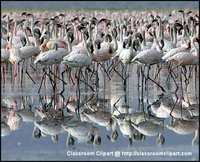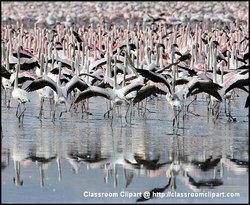Flamingo
|
|
| Flamingos | ||||||||||||
|---|---|---|---|---|---|---|---|---|---|---|---|---|
 Flamingos. Lake Nakuru, Kenya Africa. Image provided by Classroom Clipart (http://classroomclipart.com) | ||||||||||||
| Scientific classification | ||||||||||||
| ||||||||||||
| Species | ||||||||||||
|
Phoenicopterus roseus |
Flamingos (genus Phoenicopterus monotypic in family Phoenicopteridae) are gregarious wading birds, usually 3–5 feet in height, found in both the western and eastern hemispheres. They are more numerous in the latter, but there are four species in the Americas against two in the Old World. Flamingos live in large flocks in aquatic areas.
The larger species breed and feed in saline or brackish habitats. Nests are made of compacted mud and are in the form of a mound with a concave top, into which the single white egg is laid.
Flamingos filter-feed on shellfish and algae. Their oddly-shaped beaks are specially adapted to separate mud and silt from the food they consume, and are uniquely used upside-down. The filtering of food items is assisted by hairy structures called lamellae which line the mandibles, and the large rough-surfaced tongue.The young hatch with white plumage, but the feathers of a flamingo in adulthood range from light pink to bright red, due to carotenoids obtained from their food supply. All flamingos have 12 black flight feathers in each wing.
Flamingos produce a “milk” like pigeon milk due to the action of a hormone called proclatin (see Columbidae). It contains more fat and less protein than the latter does, and it is produced in glands lining the whole of the upper digestive tract, not just the crop. Both parents nurse their chick, and young flamingos feed on this milk, which also contains red and white blood cells, for about two months until their bills are developed enough to filter feed.
Classification

Flamingos are related to other large wading birds as follows:
- Order Ciconiiformes
- Family Cochlearidae, (Boatbill)
- Family Balaenicipitidae, (Shoebill)
- Family Scopidae, (Hammerkop)
- Family Ciconiidae, (storks)
- Family Threskiornithidae, (ibises and spoonbills)
- Family Phoenicopteridae (sometimes classed as an order Phoenicopteriformes.)
- Greater Flamingo (Phoenicopterus roseus), Africa, southern Asia and southern Europe.
- Lesser Flamingo (Phoenicopterus minor), mainly in southern Africa, but the most numerous species.
- James's Flamingo (Phoenicopterus jamesi) northern Andes
- Andean Flamingo (Phoenicopterus andinus), southern Andes
- Chilean Flamingo (Phoenicopterus chilensis), most widespread South American flamingo.
- Caribbean Flamingo (Phoenicopterus ruber), until recently considered a subspecies of Greater Flamingo. It breeds in the Caribbean and once inhabited Florida,
- Family Ardeidae, (herons, egrets, and bitterns)
Popular culture
Flamingos are a model for plastic yard art which is apparently popular in some areas of the USA.
Flamingo Land Theme Park and Zoo is an amusement park in the UK.
External links
- Flamingo resources from Bird Online (http://www.birdonline.org/birds/flamingos.htm)
- http://www.seaworld.org/infobooks/Flamingos/home.html


